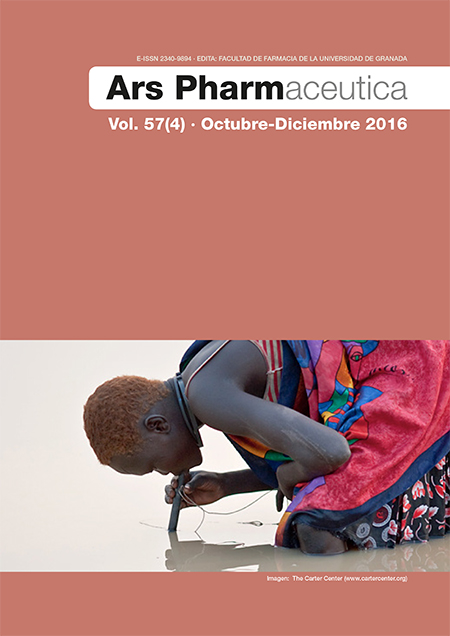News introduced by the new Real Legislative Decree 1090/2015 of clinical trials with medicines in Spain
DOI:
https://doi.org/10.30827/ars.v57i4.5563Keywords:
Clinical trials, medicines, multicenter studies, Spanish Agency for Medicines and Health Products (SAMHP), Royal Decree 1090/2015, Ethics CommitteesAbstract
Introduction: The participation of Spain in clinical trials is a reliable proof of its development in I+D in the health sector and of trying to follow at the vanguard of medical research.
The new Regulation of the European Parliament and of the Council on Clinical Trials on medicines for human use (EU Regulation 536/2014, 16th April) derogates the legislation currently in force (Directive 2001/20/EC, 4th April) and it obliges to modify the Spanish Royal Decree (RD 223/2004, 16th February) to develop those aspects that are left in the hands of national legislation.
Objetives: To analyze the main changes introduced by the new RD in clinical research (RD 1090/2015, 4th December), which regulates clinical trials with medicines, the Committees on Ethics of Research with Medicines (CERm) and the Spanish Registry of Clinical Trials and to compare them with the previous legislation.
Material and methods: RD 1090/2015, 4th December was analyzed against RD 223/2004, 16th February, and the most important differences between the two regulations were compared.
Results: The new regulatory development introduces important innovations. It opens the option for the unification of the analysis of the applications, so that, together with the authorization of the clinical trial issued by the SAMHP, it is only necessary that an accredited CERm emits its positive opinion that it will be binding. It regulates new definitions, such as the low-level clinical trial, subject to less stringent standards. It differentiates between Research Ethics Committee (REC) and CERm, establishing additional requirements to move from being REC to CERm. It defines non-commercial clinical research (in which the sponsor is a university, hospital, public scientific organization, non-profit organization, patient organization or individual researcher without involvement of the pharmaceutical industry). It opens the option to contract a clinical trial prior to its authorization. It defines compensation for damages and how the evaluation of clinical trials is conducted. It incorporates the figure of the legally designated representative for incapable and minor subjects. It stipulates the conditions in situations of urgency, pregnant and periods of lactation as well as informed consent. The main novelty is the single dossier of the two-part clinical trial, one for European Union (Part I) and another one for National Documentation (Part II). All data must be sent to a database and a European public access web portal.
Conclusions: The new regulation proposes to give an important impulse to the clinical research in Spain with medicines, simplifying the administrative obstacles and speeding up the realization of multicentric studies simultaneously in all Europe. It improves the delimitation of the responsibilities of the agents involved, it increases the safety of the test subjects, and at the same time, it increases the efficiency in the evaluation and communication processes involved.
Downloads
References
Fernández de Uzquiano E, Lavilla Uriol P, Álvarez-Sala WR. Funcionamiento del Comité de Ética del hospital antes y después de la entrada en vigor del Nuevo Real decreto 223/2004 de Ensayos clínicos con Medicamentos. Revm Clin Esp. 2005; 205 (10):493-495.
Agencia Estatal Boletín Oficial del Estado. Real Decreto Legislativo 1/2015, de 24 de julio, por el que se aprueba el texto refundido de la Ley de garantías y uso racional de los medicamentos y productos sanitarios. [Internet]; [citado el 1 abril 2016]. Disponible en: https://www.boe.es/diario_boe/txt.php?id=BOE-A-2015-8343
Agencia Estatal Boletín Oficial del Estado. Real Decreto 223/2004, de 6 de febrero, por el que se regulan los ensayos clínicos con medicamentos. [Internet]; [citado el 1 abril 2016]. Disponible en: https://www.boe.es/diario_boe/txt.php?id=BOE-A-2004-2316
Garrido Cuenca, N M. La Modificación del marco normativo de los ensayos clínicos. Publicaciones jurídicas. (www.uclm.es/centro/cesco). Publicado el 15 enero de 2016. [Internet]; [citado el 20 diciembre 2016]. Disponible en: https://www.uclm.es/centro/cesco/pdf/trabajos/35/40.pdf
Agencia Estatal Boletín Oficial del Estado. Real Decreto 1090/2015, de 4 de diciembre, por el que se regulan los ensayos clínicos con medicamentos, los Comités de Ética de la Investigación con medicamentos y el Registro Español de Estudios Clínicos. [Internet]; [citado el 1 abril 2016]. Disponible en: https://www.boe.es/diario_boe/txt.php?id=BOE-A-2015-14082
Lupicinio, Internacional Law firm. Entra en vigor el nuevo Real Decreto sobre Ensayos Clínicos. [Internet]; [citado el 20 noviembre 2016]. Disponible en: http://www.lupicinio.com/entra-en-vigor-el-nuevo-real-decreto-sobre-ensayos-clinicos/
Documento de instrucciones de la Agencia Española de Medicamentos y Productos Sanitarios para la realización de ensayos clínicos en España. [Internet]; [citado el 20 noviembre 2016]. Disponible en: http://www.aemps.gob.es/investigacionClinica/medicamentos/docs/Instrucciones-realizacion-ensayos-clinicos.pdf
Downloads
Published
How to Cite
Issue
Section
License
The articles, which are published in this journal, are subject to the following terms in relation to the rights of patrimonial or exploitation:
- The authors will keep their copyright and guarantee to the journal the right of first publication of their work, which will be distributed with a Creative Commons BY-NC-SA 4.0 license that allows third parties to reuse the work whenever its author, quote the original source and do not make commercial use of it.
b. The authors may adopt other non-exclusive licensing agreements for the distribution of the published version of the work (e.g., deposit it in an institutional telematic file or publish it in a monographic volume) provided that the original source of its publication is indicated.
c. Authors are allowed and advised to disseminate their work through the Internet (e.g. in institutional repositories or on their website) before and during the submission process, which can produce interesting exchanges and increase citations of the published work. (See The effect of open access).























